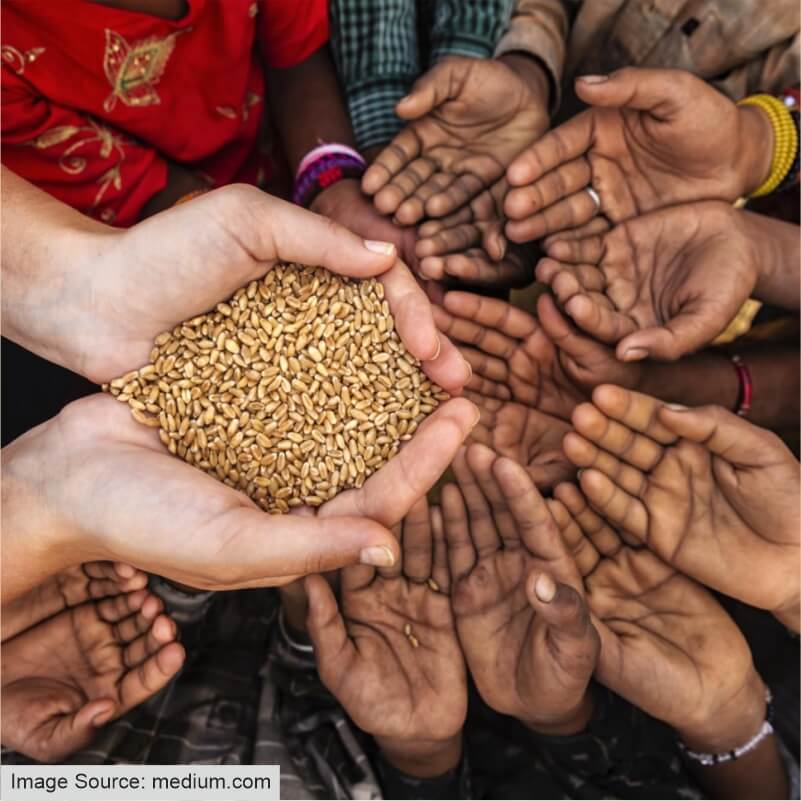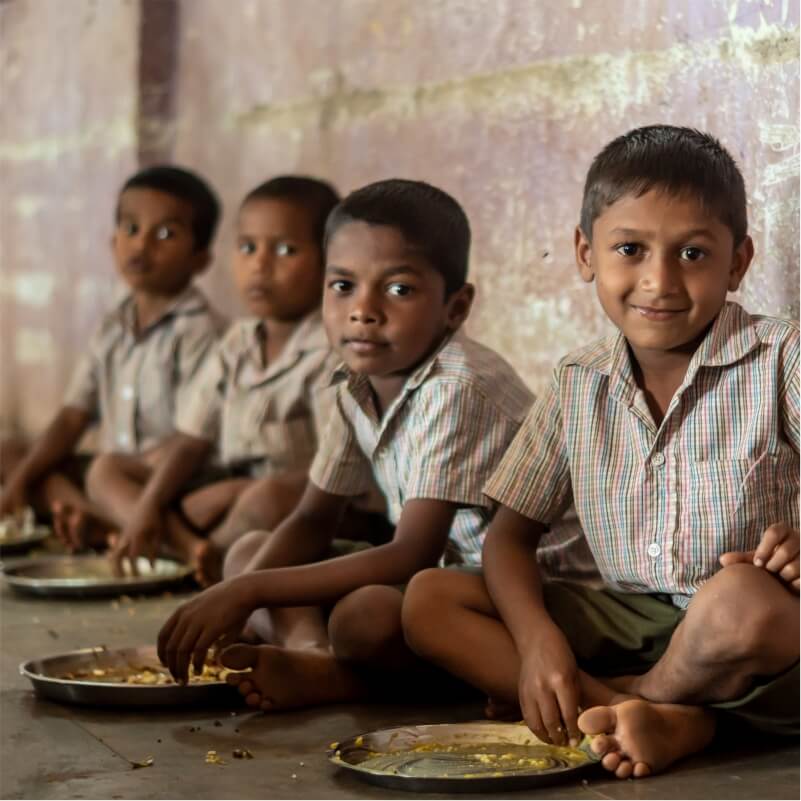Goal 2 of the Sustainable Development Agenda, also known as SDG2, strives to achieve "zero hunger or no hunger throughout the world." The General Assembly widely accepted the Sustainable Development Goal (SDG) to be achieved within the 2030 timeframe. The SDGs are based on the idea of "leaving no one behind." As millions of people go hungry everyday SDG2 establishes the groundwork for eradicating all forms of hunger and malnutrition and ensuring enough adequate food for everyone. The importance of eradicating hunger is driven by our desire for our family to have access to enough wholesome meals. Our economy, health, education, equality, and social development will benefit from a world where there is no hunger.
The stated mission statement of SDG2 is to "End hunger, establish food security, improve nutrition, and promote sustainable agriculture". In order to fulfill their target for this mission there are eight goals proposed by the United Nations:
1. Universal access to safe and nutritional foodThe primary target of SDG2 is to eliminate hunger and guarantee that everyone has access to adequate, safe and nutritious food throughout the year, with a focus on the underprivileged and those in vulnerable situations, such as infants. Food security is a person's ability to obtain food that is both safe as well as sufficient for normal development, growth and an active, healthy life. The primary measure of hunger used by the Food and Agricultural Occupation of the UN is the prevalence of undernourishment. The indicators listed below are-
2. End all forms of malnutritionTo end all types of malnutrition by the year 2030, including exceeding international aims for avoiding stunting and wasting in children under the age of five. It also aims to take care of nutritional needs of older people, pregnant and lactating women and teenage females. Stunted growth is seen in children whose height is below the World Health Organisation Child Growth Standard and when a child's weight is greater than and below the median for their height, it is said that the child is "wasted.”
3. Double the productivity and income of small scale food producersThis goal aims to increase agricultural productivity and income of small-scale food producers, particularly in women, indigenous people, pastoralists and fishers, family farmers through secure and equal access to land, other productive resources and inputs, financial services, knowledge, markets and opportunities for value addition and non-farm employment.

4. Sustainable food production and resilient agricultural practises
Implementing resilient agricultural practices that boost productivity and production, support ecosystem preservation, strengthen capacity for adaptation to climate change, extreme weather, drought, flooding, and other disasters, and gradually improve land and soil quality also to ensure sustainable food production systems. The UN states that by 2030, sustainable agriculture will be a vital area. This is mainly to focus on solving the problem with farming techniques to promote sustainable farming practices.
5. Maintain genetic diversity in food productionTo maintain genetic diversity of seeds, farmed and domesticated animals and other wild species, cultivated plants, including soundly managed and diversified seeds and plan banks at regional, national and international levels. Mainly for the reasons that food security, proper nutrition and growth in agricultural output all depend on biodiversity.
6. Invest in rural Infrastructure, agriculture research, technology and gene banksTo increase investments through enhanced international cooperation in rural infrastructure, extension services, agricultural research, technology development, plan and livestock gene banks in order to improve agricultural productive capacity in developing countries. Accelerated growth in the agricultural economy is required to end the vicious cycle of severe undernourishment, poverty and malnutrition.
7. Prevent agricultural trade, restriction, market distortion and export subsidiesThe seventh target is to correct and prevent trade restrictions and distortions in the world agriculture market through the parallel elimination of all agricultural export subsidies and all export measures with equivalent effect, by the mandate of the Doha Development Round. The two indicators are -
“Producer Support Estimate"- An indicator of the annual monetary value of gross transfers from consumers and taxpayers that is to support agricultural producers, measured at the farm gate level, arising from policy measures, regardless of their nature, objectives or impacts on farm production or income.
“Agricultural export subsidies"- Export subsidies are an increase in the share of the exporter in the world market at the cost of others. This tends to depress world market prices and may make them more unstable, because decisions on export subsidy levels can be changed unpredictably.
Adopting such measures to ensure the proper functioning of food commodity markets and their derivatives and facilitate timely access to market information, including food reserves in order to help limit extreme food price volatility. The domestic food price volatility index, calculates the weighted average of a basket of commodities based on market or consumer prices, tracks changes in domestic food prices over time. High values suggest a higher degree of food price fluctuation. Extreme fluctuations in food prices are dangerous for agricultural markets, people's food security, and lives in general, especially the most vulnerable.
THE CHALLENGES OF SUSTAINABLE DEVELOPMENT GOAL 2Many small-scale farmers and farmworkers are poor and regularly experience food insecurity. They have limited access to services, capacity or market resources. Small-scale producers consistently outperform larger firms in terms of income and productivity. Investment in the agriculture industry is essential to improve food security, minimize poverty and hunger, increase resilience to disasters and other emergencies, and to create jobs as it is one of the most important sectors.
Malnutrition has a high financial cost for nations since it affects people at every stage of life and increases the chance of developing certain diseases, missing work and passing away. Early cognitive development is impacted by chronic starvation, and learning difficulties later in life.

WAYS TO SUPPORT SUSTAINABLE DEVELOPMENT GOAL 2
There are different ways one can support the initiative of the zero hunger goal. They can locate “zero hunger” by making any donation, no matter how modest, it will have an impact. Purchase seasonal and local food and consider growing your food to avoid wasting food. Additionally, small yet significant steps can be taken to freeze fresh food and leftovers if you cannot consume your food before it goes bad. Buying those nutritious fruits that might otherwise go to waste as fruits are thrown away due to its bad form. Consider cutting back on your meat consumption and turning vegan once a week as the production of meat has a significant impact on the food sector.
Child Help Foundation also has taken various initiatives in promoting “Zero Hunger” as its aim to eliminate the challenges and obstacles that put the children through suffering. We believe that no child should go to bed hungry, so Child Help Foundation and its partner NGOs provide warm, nourishing meals every day to children. In collaboration with Roti Ghar, 1,800 children are being served food everyday. You can donate as a gesture of support for Child Help Foundation's mission to end world hunger and bring joy to thousands of children. Till November 2022, 17,83,657 children have been benefited by our projects undertaken as a part of Zero Hunger.
These Global Goals are in place to promote important discussions. The Sustainable Development Goals can be used to implement projects and raise awareness of the major issues facing the globe. Small acts by you will have a huge impact when the notion of Zero Hunger is realized and we start moving towards a world free from hunger and food insecurity.
“If you cannot feed a hundred people, feed just one” - Mother Tressa.
